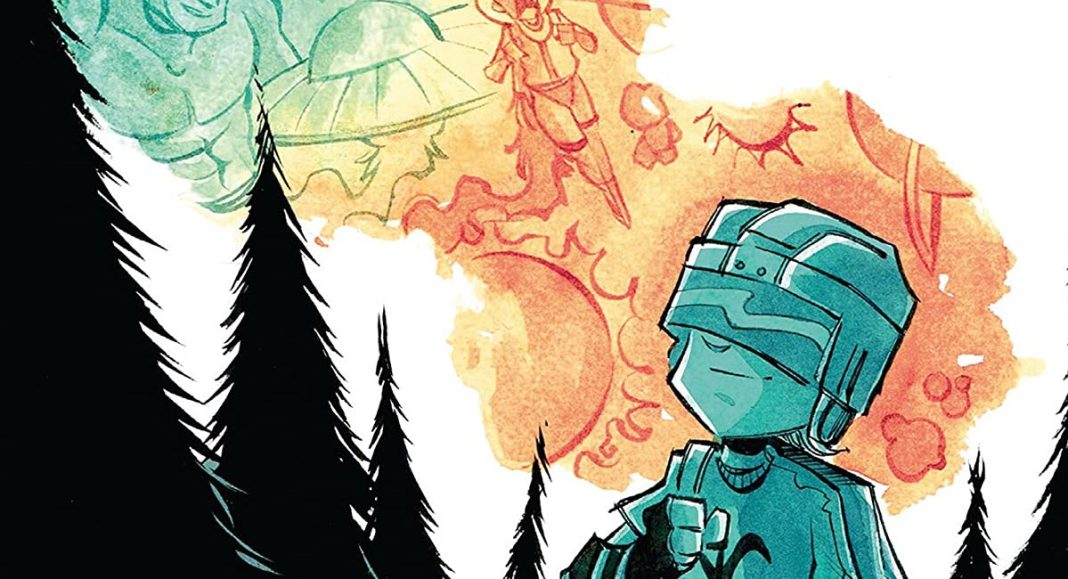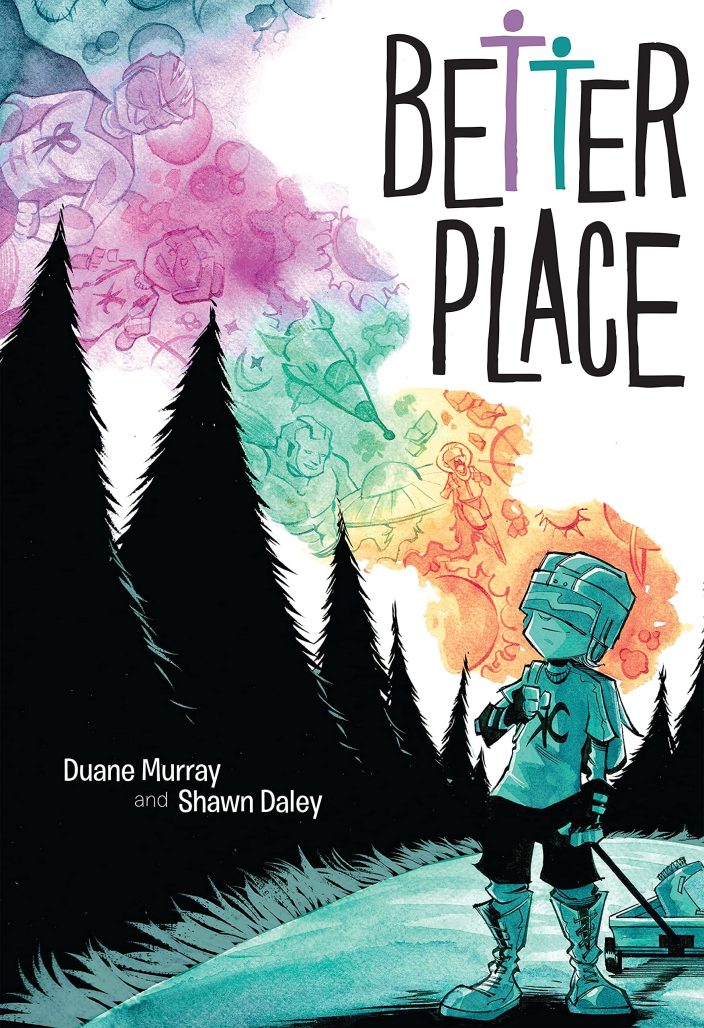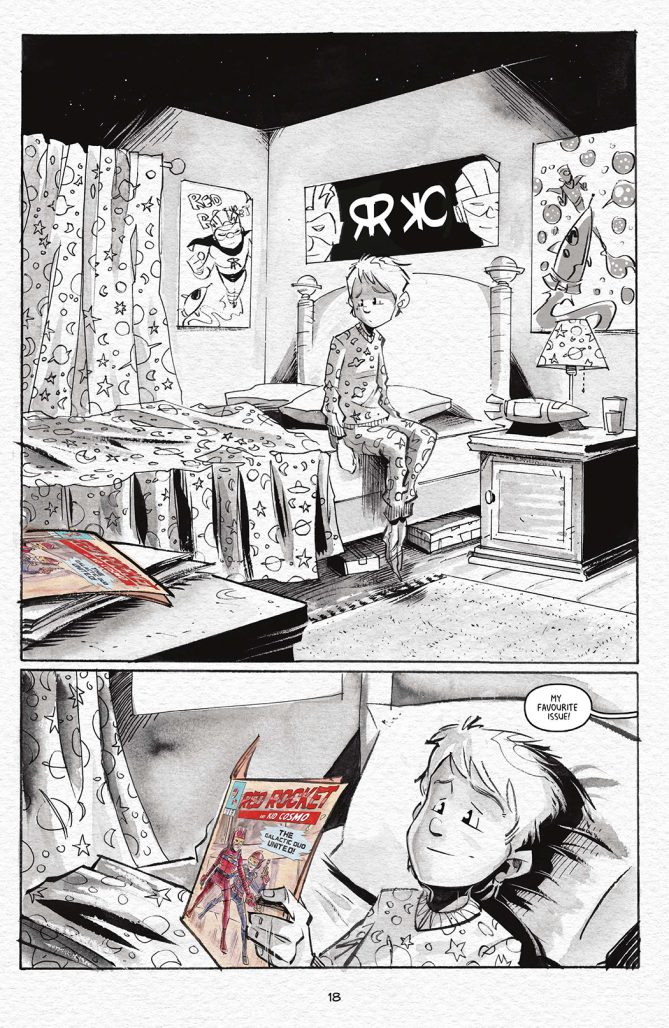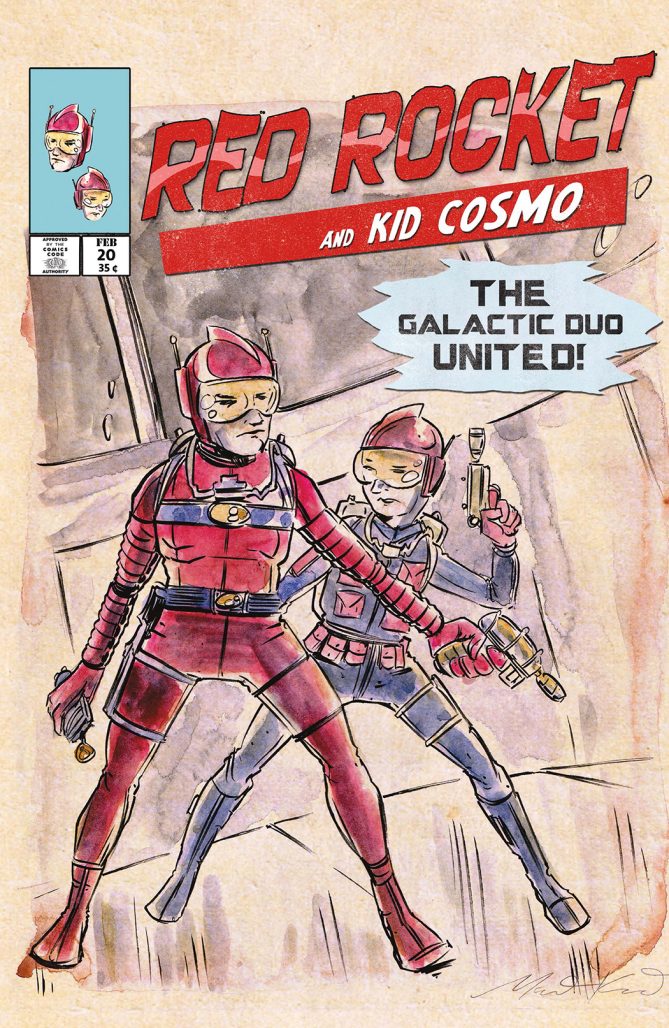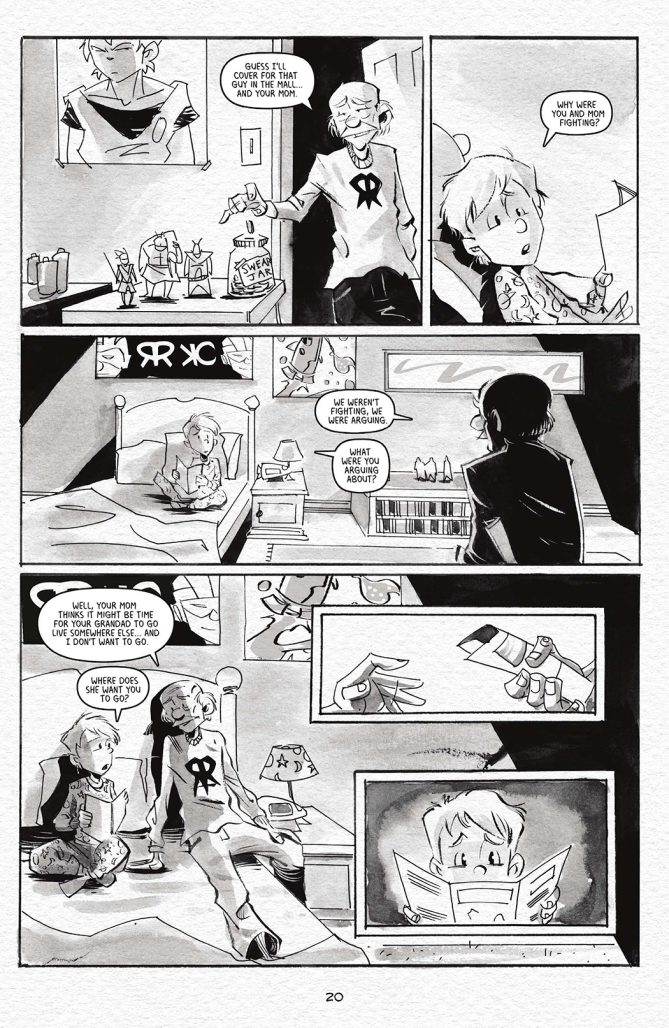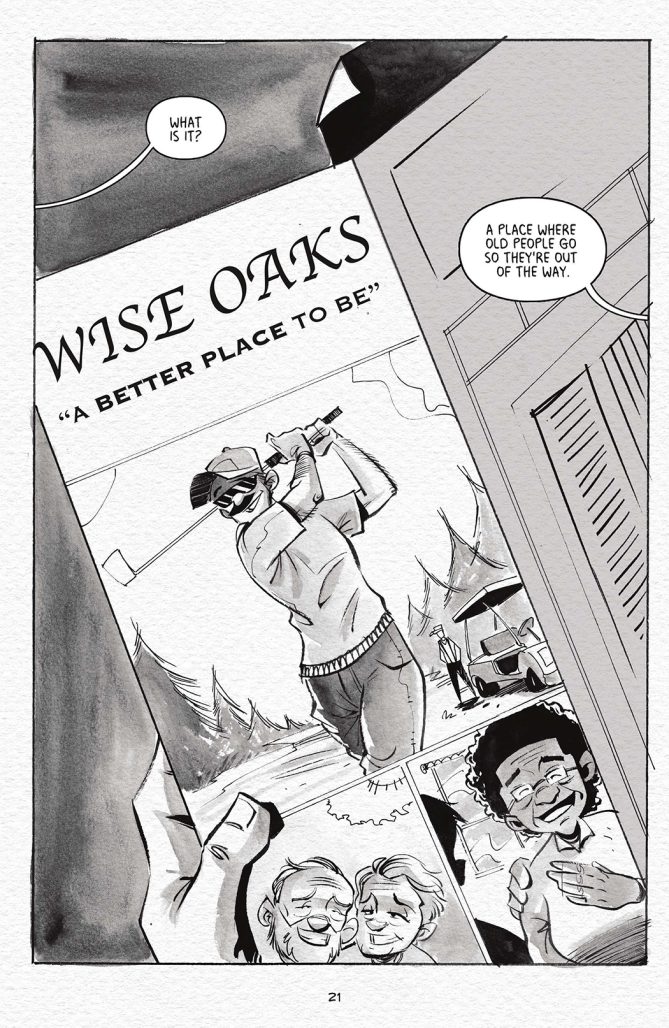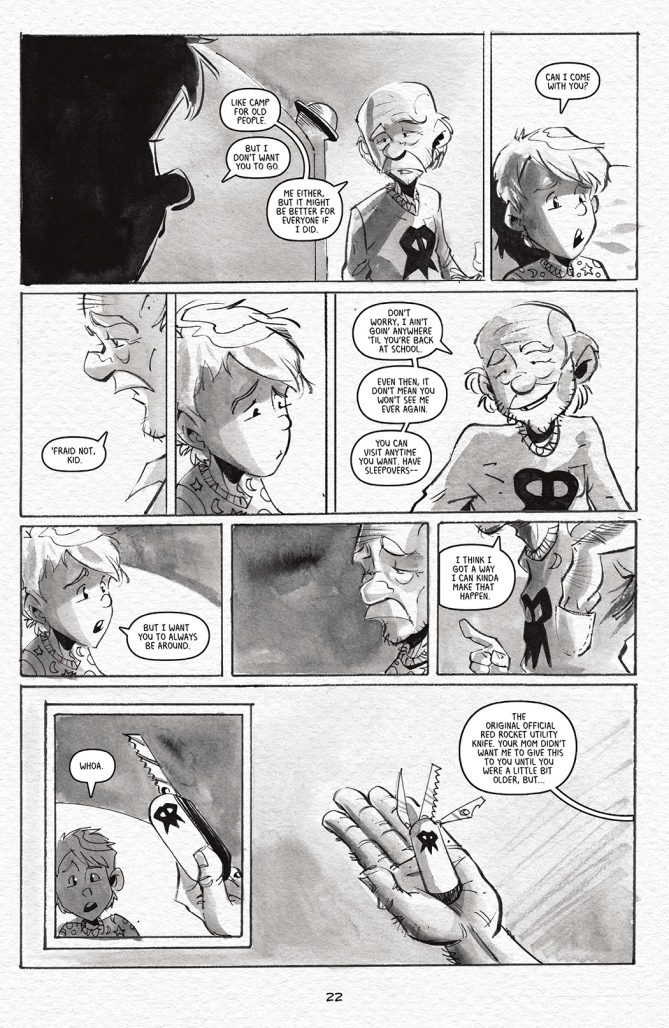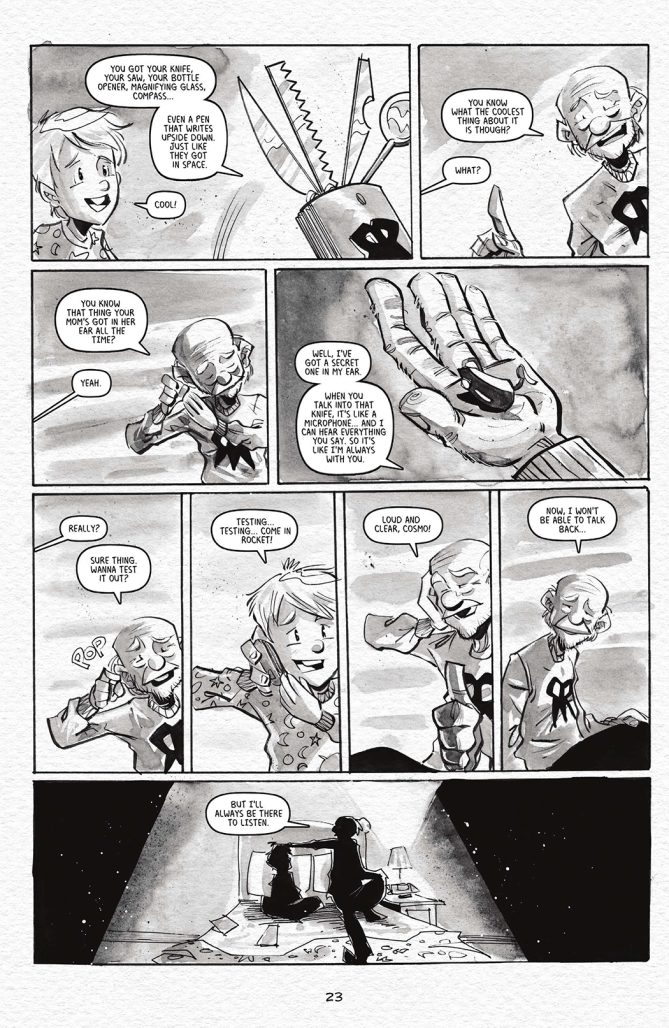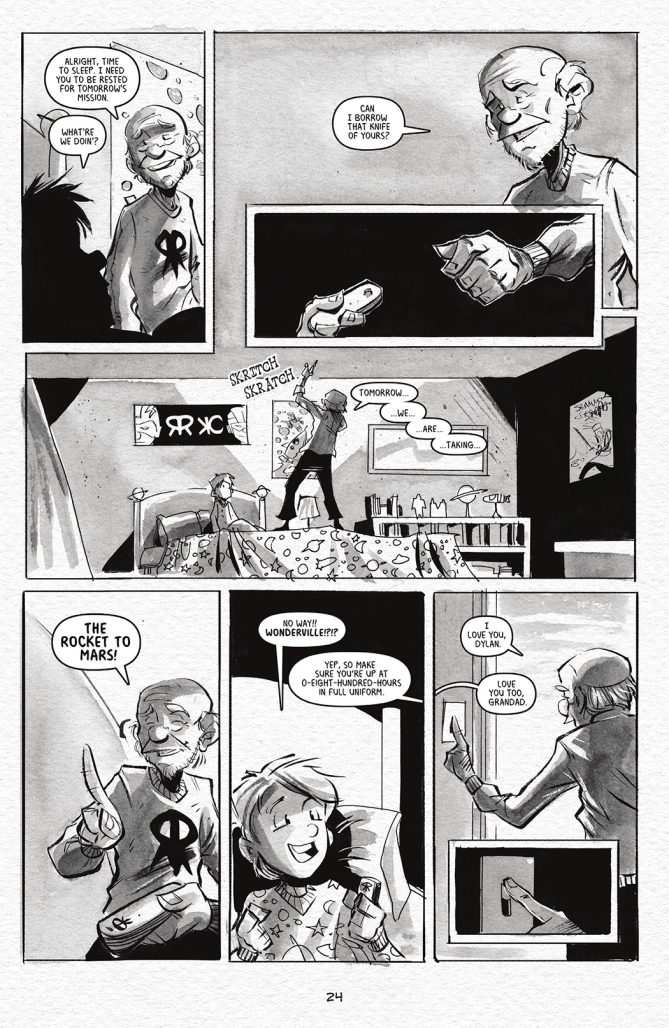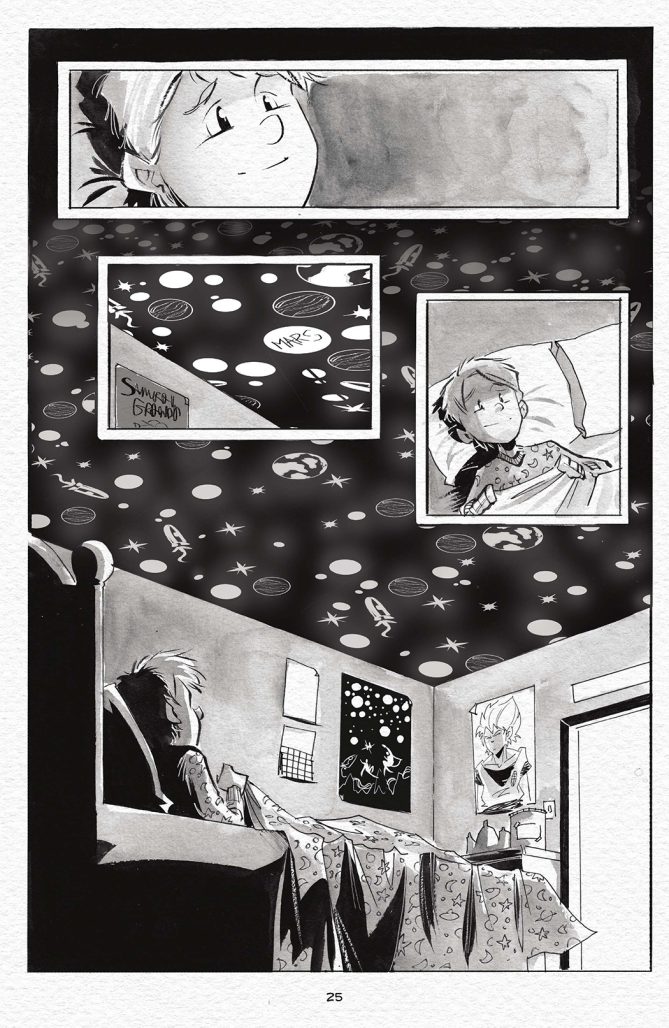Next week sees the release of Better Place, a new all-ages graphic novel from IDW’s Top Shelf Comics imprint. Written by Duane Murray and illustrated by Shawn Daley, with guest art contributions from top comics talents including Jeff Lemire, Nate Powell, and Matt Kindt, the graphic novel follows Dylan, a young boy dealing with the unexpected loss of his grandfather. Today The Beat is happy to debut an exclusive excerpt from Better Place, as well as a trailer for the book.
Here’s how Top Shelf describes Better Place:
This sidekick misses his superhero… After hearing that his grandfather has gone to a “better place”, a boy sets off on a grand adventure to find him, dressed as his favourite comic book character.
Dylan just moved to a new house, with no friends, and a mother who doesn’t have time for him. Luckily, he has his grandad. Together, they are Red Rocket and Kid Cosmo, who save the universe every day with the power of imagination! But one day, Dylan learns that his grandad is suddenly gone… to a “better place.” Now, Kid Cosmo will have to save the day, all by himself.
And here’s the trailer from IDW/Top Shelf, which spotlight’s Daley’s artwork and the simultaneously epic and personal scope of the story being told.
Along with the excerpt from the graphic novel, writer Duane Murray took the time to answer a few questions about this, his first graphic novel. Murray discusses the development of Better Place, why comics was the right medium for the story, what Shawn Daley brought to the project, and much more. Check that out, along with the exclusive eight-page excerpt from the book, below, and look for Better Place in bookstores next Tuesday, October 26th, and in comic shops the following Wednesday, October 27th.
Joe Grunenwald: What was the origin of Better Place? Did you and Shawn Daley develop it together?
Duane Murray: The origin story of Better Place is a long one. Shawn and I did not develop it together, but the book is what it is because of Shawn, if that makes sense. Better Place was originally developed as a micro-budget film, starting about 20 years ago when the idea of someone wandering around looking for a loved one who died after they were told they had gone to a ‘better place’ came to me after seeing the movie Gerry. Though always a lover of comics, because I can’t draw and really was still only into superhero comics at the time, I only thought of visual, self-contained stories as films. And of course, with DV cameras, indie films were the thing in the early 2000s. My best friend and I dreamed of making films together (and we later would and still do), and so we started banging around the idea together through several iterations (too many to mention), and had lots of false starts in terms of a script and producer interest and eventually it ‘died’.
Eventually, years later obviously, it dawned on me after having read several non-superhero graphic novels, that the best way to tell this story was actually in that format. So, with my best friend’s blessing, I took my original idea, and some of the stuff we were trying to do in the script, and spent about a year, every day, ‘adapting’ it as a graphic novel. Which is the important part to mention, because I think there are writers out there, who when their screenplays don’t get sold or produced or whatever, who want to turn those screenplays into graphic novels and/or comics, and think all they have to do is hand the screenplay over to an artist and ‘blammo!’, you have a graphic novel. Luckily, I have not only been a comic fan my whole life, but worked closely in some adaptations of graphic novels, and participated closely in other aspects of that industry, and so knew for me to do this, it wasn’t just as simple as doing a slight adjustment of the incomplete screenplays, but would need to rethink the entire story. So that’s what I did. And when I was done, I went out with a half-complete script (thought a complete outline) and went after Shawn to draw it. And then from there to publication is a whole other origin story that I will save for now… until our big follow up interview!!!
Grunenwald: You’re known primarily as an actor, though you’ve done some writing for the screen as well. What made you want to branch into comics? Have you always been a comic fan?
Murray: Ha! Well, I don’t think I am primarily ‘known’ as anything to anyone outside being a dad to my daughter, and a guy who is in some stuff to a small circle of friends, but yeah, my career has been primarily in the film and TV industry, with most of my known work as an actor. To answer the question though, yeah, I have always been a comics fan. Ever since I can remember. I still have some comics from the late ‘70s I used to read at the cottage from my Uncle’s box under the bed, and the first comic I bought off a news stand with my own money (Batman #417!), and then random nostalgic issues through the ‘90s and 2000s that I kept. I sold most of my collection to get into original art collecting. I had over 20 long boxes and am down to 2. I pretty much only read individual issues digitally now, but also have my favourite trades on the book shelf.
I guess what made me want to branch into comics was the realization I could. This first started in about the mid-2000s when I started to drift toward non-superhero stuff. And it was the stuff by Jeff Lemire, Matt Kindt, Nate Powell and others that showed me that grounded, emotional, yet with an element of the fantastical could be told in this format. The thing is, because these guys could all draw and I couldn’t, I still never thought of actually writing something for the medium. And it was actually Kickstarter where I saw people raising money to pay for artists, and a place where you could print your book without a publisher having to ‘accept’ your book, that I realized I could just hire an artist.
So, because I was a producer of micro-budget indy films, I was pretty resourceful in just making projects happen. I had some money put away and so decided I would hire the artist and make the book and then just go to Kickstarter for a print run. But, when the book was done, on a whim, I sent it to Top Shelf since they were my dream publisher and their mid-2000s books kind of inspired this book, and [publisher/editor] Chris [Staros] got back to me and said he was interested in publishing it. And now here we are and I still can’t really believe it. And now, for the stories I want to tell anyway, I kind of only want to tell them in graphic novel or comic form. Already planning the next one!
Grunenwald: Tell us a little bit about Dylan. How much of the character and what he’s going through in this book is pulled from you or Shawn’s own experiences?
Murray: I can’t speak for Shawn obviously, though has said that he had lost his Grandfather around the time of working on the book, and so that it was very cathartic for him. He has also said that he experienced some of the things Dylan experienced, so I am sure that shows up in the art, but I didn’t directly pull anything from Shawn for the book. I did borrow heavily from myself. Ha! There are things about Dylan that are directly taken from me, there are things about Dylan that are exaggerated things about me, and there are things about Dylan that have nothing to do with me.
Dylan’ relationship to his Grandfather is loosely based on my relationship to my Grandfather, with a sprinkle of my Uncle and my Grandmother. I was a shy only-child of a single mother who worked a lot, but she didn’t rush my “growing up”. She just wasn’t around much and I was a latch key kid. It did mean I was often by myself and created fantasy worlds which I played in. I absolutely used to ride shopping carts down mall parking ramps while narrating. I just did it by myself. My Grandfather and I would pretend together, but it was always as a tag-team wrestling duo as opposed to comic book superheroes. He also had alzheimer’s and in the end forgot who I was. And my Grandmother was the first person I saw in a casket and I remember thinking, “That person is no longer there. It looks like them, but it’s not. They’re somewhere else.” And so the Dylan/Grandfather relationship is based on all of those things, but intensified to where Dylan’s Grandfather is his best friend, and in this situation, his only friend, and losing him means losing everything and so he will do whatever he can to be with him again. The rest is just imagination.
Grunenwald: How did Shawn’s artwork, particularly the limited color palette, impact or influence your own work on the book?
Murray: This is an interesting question, because I am not sure I know how to answer it. I’ll try describing what I went to Shawn with and our process and maybe that will answer the question. First of all, the limited colour palette was actually my idea. That being said, it wasn’t some big auteur choice as much as I was paying for all the art, and potentially printing, myself, and I knew that both the page rate for black and white art, and the printing of black and white pages was significantly cheaper. I did however want some red splashes of colour (inspired by Schindler’s List, but also Jeff Lemire’s Lost Dogs).
Now, what I didn’t know was that you couldn’t just print a couple pages in colour, and have the rest print black and white (unless you were a genius at pagination and could make it so a limited number of 4 page spreads were what had the colour). So once I knew that, all bets were off. I LOVE Shawn’s colouring, but I also still liked the idea of grayscale wash, because he’s also amazing at that. So, I guess I could say that seeing Shawn’s grayscale gave me the confidence to have the majority of the book in that colour palette, while also knowing we could have splashes of colour. And I will also say that the colour use I had in my mind was rather random, but became clearer how it would be used as I worked with Shawn and even clearer when going through editorial with Leigh [Walton] and Chris at Top Shelf.
And in terms of the overall book, working with Shawn was very collaborative. I am not sure if it impacted my writing necessarily, but it impacted what the book is, if that makes sense? There were parts in the writing I was very specific about visually, but the majority of my writing, in a visual sense, was just pacing. So I would write a page of script, and some description where I felt it necessary, and would structure it in the number of panels I thought belonged on the page. For pace. What the panels looked like in terms of composition and size and style and angle, was almost all Shawn. I would sometimes send a photo reference for a specific thing. Sometimes Shawn would suggest more pages for a sequence. Sometimes I would see a prelim and suggest a different angle. Sometimes I would say, “Dylan is on a roller coaster” and Shawn would take that sentence and turn it into 4 pages of wonderfulness. So the making of the book was incredibly collaborative and likely very different than the script, but the script or “writing” was already pretty much done when Shawn got it. Shawn’s art impacted the book in that this book would not exist as it is without Shawn. Not just the drawings in it, but the book itself.
Grunenwald: What do you hope readers take away from Better Place?
Murray: I mean, I just hope people will like it. I hope people will feel something positive after reading it. I hope it gives people the same feeling I got after reading books like Essex County, and Swallow Me Whole, and I Kill Giants and 3 Story The History of Giant Man, because those are the books that inspired how I wanted to tell this story.
Published by IDW’s Top Shelf Comics imprint, Better Place is in stores next week.


